We and others have often commented that cancer treatment is a marathon, not a sprint. Today, the literal marathon supporting St. Jude took place, including a half-marathon and the 5K that I participated in. The connection between treatment and the marathon is more than casual, something that we observed and felt first hand through the course of the day.
In the morning, I woke up bright and early to make it in good time to the suggested 6:45 line-up time. Too early, in fact. I for some reason forgot that I had never forced my phone to adjust to Central Time and was on my merry way by 5:30 rather than 6:30. It was bitterly cold, and the frosty ground was a surprise after the temperate Memphis fall weather.
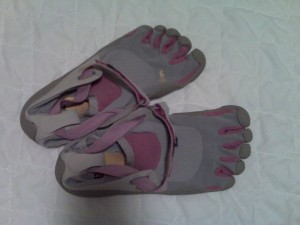
I had been cautioned not to run in my Vibram Five-Finger shoes, which offer little insulation and only millimeters of protection from the ground. However, I stuck by my guns and have gotten so accustomed to these shoes that standard running shoes feel needlessly elevated and stiff, forcing an unnatural foot strike.
Walking down Main Street, I began to question my decision regarding the shoes and, once I saw a clock that read 5:30, I realized that I had to take quick action to salvage the day. In short order, I sought refuge in a cozy boutique hotel, the Madison, and curled up in a chair in the lobby to rest until the actual race time (7:15) neared. I wasn’t able to sleep but at least thawed out my piggies and everything else.
All the patrons in the hotel was related to St. Jude, either runners or a presumed board member. The latter was an older gentleman known to the staff of the hotel who joked lightly about somebody else on staff. He said he was headed to ALSAC, St. Jude’s fundraising arm, and eventually ducked into a limo as runners gathered for an early pre-race breakfast.
ALSAC is heavily involved in the race and sponsors the St. Jude Heroes program, which embraces athletes in any event but is especially active in this particular race because of its location in Memphis and obviously strong connection with St. Jude itself. This is the first year that the course of the longer races (identical until the half-marathon peels off to the finish line) traveled through the St. Jude campus. We surmise that this is more a matter of expansion than it is design of the course, but it provided an opportunity for the hospital to sponsor active support of the race through a cheering section starting around mile four. Patients and staff were encouraged to participate. There was a similar cheering area outside of Target House, which is in a latter segment of the race.
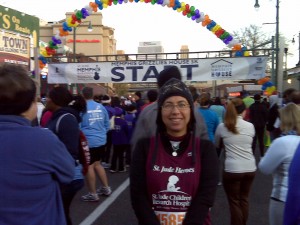
The 5K had around 4,000 registered racers, though it didn’t look that way and the results list less than 3,000. The early chill backed off somewhat as the sun rose, though it was far from balmy. I did dare to leave my jacket at the bag check area (in order to better fit in with the other parcels, my jacket was “converted” into a more baglike form by being tied into a bulky knot through the arms) at the finish line and hoped that numbness would serve in my favor once the race started. Many of the participants in this shorter race were very casual about it, which was encouraging since my training had been sporadic at best and unintentionally put on hold entirely more than a week before the race.
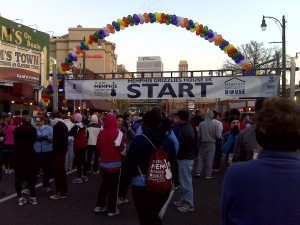
At the start, I stood near a group of young men, one of them a returning patient who had gotten a clean scan on Wednesday. The 5K in particular attracts people who want to take part in the event but don’t have there wherewithal to train for the more rigorous lengths, so there were plenty of walkers and non-serious runners. I later learned that a boy we know who is a leukemia patient going through his last course of chemo participated, finishing in just over an hour.
Stories of St. Jude patients fill the race, including parents of current patients (we know of one couple who both ran the full marathon) as well as families of children who did not survive their cancers. Many runners wear t-shirts commemorating lost children, smiling faces imprinted with birth and death dates denoted underneath. We will never forget you. Your short, sweet life will not be a waste.
This is one of the core issues with pediatric cancer: children do not have the opportunity to create a legacy, so the onus falls to the surviving family members to do it for them. At least adults who die for whatever reason do so having had an opportunity to leave a mark on this world, for better or worse. Children are robbed of this chance at immortality, and many families feel disloyal in forsaking their loved ones.
Events such as the St. Jude marathon bring out memorial groups, perhaps a catharsis for them as well as an inspiration to others. The various bobbing shirts and roadside signs remind runners of the cause they are supporting and put a face to the injustice of childhood cancer. The gleaming smile on a mundane pre-diagnosis school picture or family snapshot tells us how precious and fragile that innocence really is.
Even for the somewhat earlier and less impressive 5K race, there were live musicians playing along the course, a DJ encouraging runners near the end. The atmosphere is festive, yet one senses that this kind of community involvement is not simply endemic to the musical heritage of the city but also representative of the collective belief that St. Jude is the good-est thing that Memphis has to offer. This is true not just for the city but the region.
One of the fellows explained to me that each major cancer center has a catchment area where, based purely on geography, all patients within a given area end up there unless they have some pressing reason to go elsewhere. St. Jude’s is the largest, with Memphis in the epicenter of poverty in the South. Any child with cancer from this region ends up at St. Jude, whereas those from distant locations only come for specific studies.
As we have said before, without St. Jude, there are patients here who would otherwise receive no treatment for their cancer. That they receive the premiere care is a bonus, and the institution’s contribution to science is a vastly less relevant fact.
The opportunity to participate in the 5K has been helpful for me since training, such as it was, forced me to get outside and engage in a healthy and positive activity. I did not think much beyond this and was taken off guard by the emotional impact of the day’s events.
My race was fun and quick. I had hoped to cross the finish line in less than 45 minutes, my estimate based on almost complete ignorance of my normal pace and the assumption that I would perform poorly because of different terrain, the conditions, and deficits in training. My not-quite-official time was 28:57, and I ranked 461st overall and 172nd among the women. Not exactly competitive, but not terrible, though I should probably be mortified that plenty of small children beat me.
The race spilled out into the local AAA baseball stadium, where they also hosted a refreshment area for runners with food and beverages, including beer (Coors sponsors all local running events, evidently). For the novelty of it if nothing else, I emptied one plastic cup before 8 am and made my way back to the hospital to help get the gang out into the cheering area for the longer races.
We were concerned about the gelid temperature and Colin’s I.V., the thin tubing providing little insulation against the frigid air. I passed frosted glass bricks and a frozen fountain that gave me pause, but Dr. Baker, the doctor on service, encouraged us to take Colin outside. Dr. Baker is the ever-cheerful Bob Cratchit of St. Jude with an entire hospital of Tiny Tims to attend to.
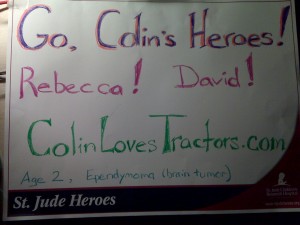
We bundled Colin up and trundled him outside with Aidan stumbling along – until instructed otherwise – in front of the wheelchair and I.V. pole. The night before, we made signs to hold up. The response from the runners was incredible. Many gave us high-fives and even stopped to say hi to the kids. Even more shouted out encouragement to us (isn’t that supposed to be the other way around?) or exclaimed, “we’re doing this for you!” This was literally true for Rebecca Adelman, whom we met through Aidan’s school and wore an “I run for Colin” sign on her back. We were very glad that we were out there when she came by and then coincidentally (when I was by myself) later in the day a mile before the finish. I regretted not bringing one of the signs out with me.
More than a few runners were visibly moved by our presence, wiping their eyes not because of the wind or cold weather. I was suddenly struck by the fact that, while we swim in these waters every day, many people even in Memphis have little direct connection with the patients here. To us, it now seems perfectly natural for children to have cancer, and seeing an individual patient face-to-face is neither momentous nor meaningful beyond our particular relationship. However, the reality of one of our symbolically afflicted children must be especially striking to the uninitiated, especially in the midst of the race.
People often extend their help to us yet feel fundamentally powerless, a sentiment that is understandably shared by many. The marathon offers a constructive outlet that also happens to represent a tremendous physical and mental trial. There is something about the exercise of taking on this challenge that says, “If I could relieve you of your burden, I would.”
At the same time, the plight of the patients of St. Jude is inspirational. After all, who would relish the rigors of chemotherapy and everything else the kids go through? Thus, the children themselves are able to spur on the runners. After all, if a small child can endure, it is easy enough to simply put one foot in front of another.
The synergy of the marathon and the children of St. Jude is elegant and powerful. The institution and its charges need the fundraising support, but so do they thrive on the energy created by the race. Many people participate not because they are eager for the physical exertion but because they want to show their support. The marathon draws running M&Ms, bananas, Christmas elves, and others who are there not for the sport but the spirit.
One of the bananas playfully pelted us with candy as if it were a juvenile Mardi Gras, thankfully no bare breasts required. This act of generosity soon inspired a distraught outburst from Colin, pained to see the treats scattered across the sidewalk. Aidan dodged runners who angled toward the sideline to high-five us to gather up the wrapped goodies as instructed. He treated the athletes like street traffic, cowering and only tentatively going after the candy, even precious chocolate-based candy bars.
As for the people who are running because of specific patients, the act of racing reclaims some power. When there is little that we actively do to fix the problem that we face, it is possible to demonstrate commitment. I can individually help raise money for the cause. I can help people remember a child who was lost to cancer. I mean this in a general sense rather than for myself as an individual.
Patients and former patients who run make a clear statement: this has not knocked me down. It is beautiful and moving simply to observe.
Cancer is not omnipotent, though it is able to shorten our days and make day-to-day living more challenging. Amid the frightening reality that it represents, there is ample opportunity to recognize the positives of human spirit, generosity and kindness that we have encountered and continue to see every day. We are heartened to see patients and their families who focus on empowerment, regardless the outcome.
For us, these days before Christmas are strangely placid. Colin initiated the fourth course of chemo and cleared the first drug, methotrexate, better than ever. In fact, they discharged us today on day five, whereas we have never left the hospital before the dreaded day eight/nine triple whammy of vincristine/cisplatin/cyclophosphamide.
Colin returns to the hospital on Thursday to continue chemo, anticipating a hard five to six days to follow. However, we hope to be out by Christmas and hopefully even recovered from neutropenia. Colin’s last MRI takes place before New Year’s Eve, and we have been led to expect that it will take another two weeks to get an opinion from St. Jude’s tumor board about whether Colin will need another surgery before radiation.
Neurologically, Colin has been doing better and better. Not only is he dramatically more alert and aware of his situation, but he is using his mouth and tongue a lot. Some of his favorite playthings are plastic and rubber food, in particular a squishy cheeseburger in the play room upstairs that he has been known to fall asleep with.
Today in speech therapy, Colin opened his mouth wide for a lollipop and chomped down on it with a crack. The therapist did a quick finger sweep of his mouth to fish out the fragment of grape lollipop that he snapped off. We were surprised if only because he had not opened his mouth that wide intentionally since the second surgery!
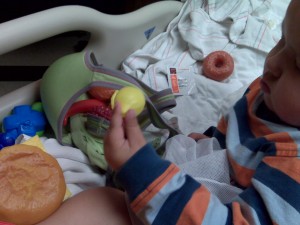
To us, he is more like the pre-diagnosis Colin, crinkling his nose expressively and joking around. He is quick to provide his opinion and resist treatment. The other night, he refused to have his blood pressure or temperature taken until I submitted to it myself. Pretty soon, one of us is going to have to get accessed by a port needle (ouch!).
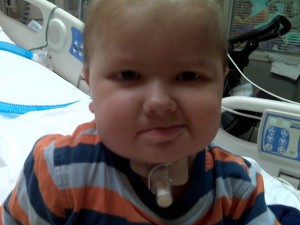
The better Colin gets, the more intimidating the idea of surgery is. After all of this progress, it is painful to imagine losing ground and stealing these advances from him. However, the price of leaving excessive tumor is worse. Until the final scan, we don’t know what the risks and benefits will be, so until then we float along in the toxic certainty of chemo.
Lucky thirteen days to go, and counting: go little fellah go here’s, a high five from grandpa for good news in two weeks!!!
congrats on the race! thinking of you guys alot and sending best wishes!
oxoxo
ps – john and i are moving this weekend : )
thanks for the updates – i hope that LOTS of money was raised to support a cause that touches so many lives!
it is so good to hear of Colin’s progress and see pictures!!
Keep fighting Colin – high-five!
Tamiko,
I was cheering you on from CO and see that my efforts paid off. And here’s even more cheers that Colin is doing so well. Thanks for the updates.
Love, Diana